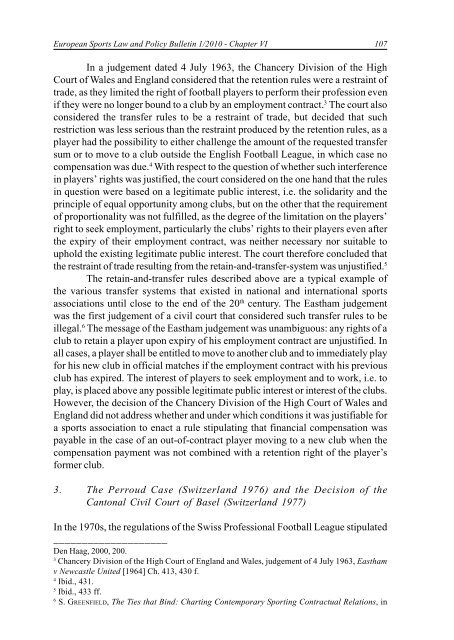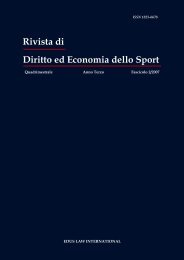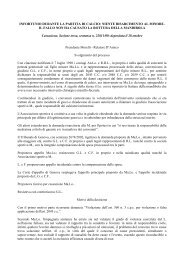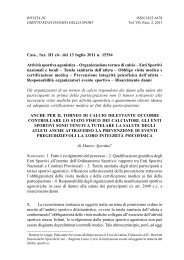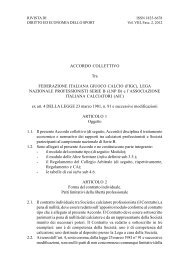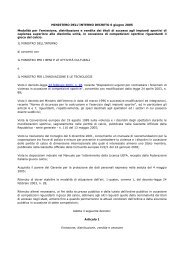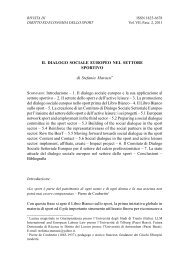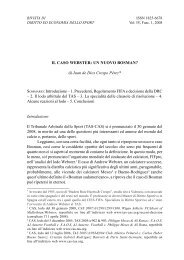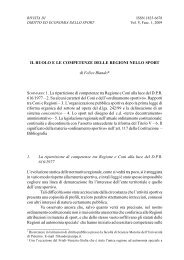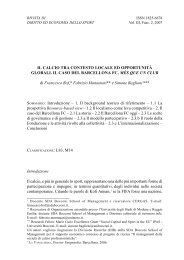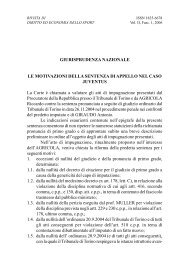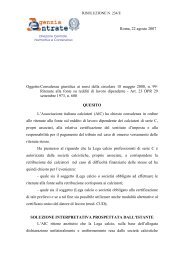European Sports Law and Policy Bulletin THE BERNARD ... - Slpc.eu
European Sports Law and Policy Bulletin THE BERNARD ... - Slpc.eu
European Sports Law and Policy Bulletin THE BERNARD ... - Slpc.eu
Create successful ePaper yourself
Turn your PDF publications into a flip-book with our unique Google optimized e-Paper software.
<strong>European</strong> <strong>Sports</strong> <strong>Law</strong> <strong>and</strong> <strong>Policy</strong> <strong>Bulletin</strong> 1/2010 - Chapter VI 107In a judgement dated 4 July 1963, the Chancery Division of the HighCourt of Wales <strong>and</strong> Engl<strong>and</strong> considered that the retention rules were a restraint oftrade, as they limited the right of football players to perform their profession evenif they were no longer bound to a club by an employment contract. 3 The court alsoconsidered the transfer rules to be a restraint of trade, but decided that suchrestriction was less serious than the restraint produced by the retention rules, as aplayer had the possibility to either challenge the amount of the requested transfersum or to move to a club outside the English Football League, in which case nocompensation was due. 4 With respect to the question of whether such interferencein players’ rights was justified, the court considered on the one h<strong>and</strong> that the rulesin question were based on a legitimate public interest, i.e. the solidarity <strong>and</strong> theprinciple of equal opportunity among clubs, but on the other that the requirementof proportionality was not fulfilled, as the degree of the limitation on the players’right to seek employment, particularly the clubs’ rights to their players even afterthe expiry of their employment contract, was neither necessary nor suitable touphold the existing legitimate public interest. The court therefore concluded thatthe restraint of trade resulting from the retain-<strong>and</strong>-transfer-system was unjustified. 5The retain-<strong>and</strong>-transfer rules described above are a typical example ofthe various transfer systems that existed in national <strong>and</strong> international sportsassociations until close to the end of the 20 th century. The Eastham judgementwas the first judgement of a civil court that considered such transfer rules to beillegal. 6 The message of the Eastham judgement was unambiguous: any rights of aclub to retain a player upon expiry of his employment contract are unjustified. Inall cases, a player shall be entitled to move to another club <strong>and</strong> to immediately playfor his new club in official matches if the employment contract with his previousclub has expired. The interest of players to seek employment <strong>and</strong> to work, i.e. toplay, is placed above any possible legitimate public interest or interest of the clubs.However, the decision of the Chancery Division of the High Court of Wales <strong>and</strong>Engl<strong>and</strong> did not address whether <strong>and</strong> under which conditions it was justifiable fora sports association to enact a rule stipulating that financial compensation waspayable in the case of an out-of-contract player moving to a new club when thecompensation payment was not combined with a retention right of the player’sformer club.3. The Perroud Case (Switzerl<strong>and</strong> 1976) <strong>and</strong> the Decision of theCantonal Civil Court of Basel (Switzerl<strong>and</strong> 1977)In the 1970s, the regulations of the Swiss Professional Football League stipulated____________________Den Haag, 2000, 200.3Chancery Division of the High Court of Engl<strong>and</strong> <strong>and</strong> Wales, judgement of 4 July 1963, Easthamv Newcastle United [1964] Ch. 413, 430 f.4Ibid., 431.5Ibid., 433 ff.6S. GREENFIELD, The Ties that Bind: Charting Contemporary Sporting Contractual Relations, in


